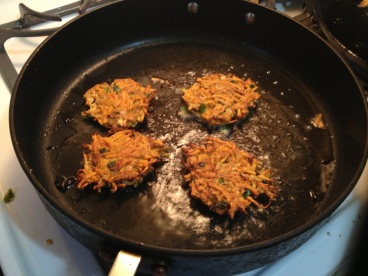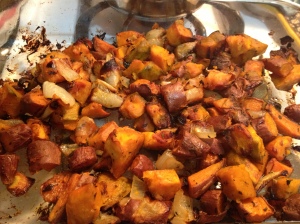
Today I had to good fortune of hearing a talk about breathing by Mark Gerow, a NY City Actor, a yoga instructor, founder of Lunarhythms, and survival instructor in the U.S. Air Force. I was not sure if this lecture was going to be for me, but I heard he was a great speaker. And indeed he was; he was able to connect breathing to the greater health of our bodies, and I was sold.

Good Posture
I walked in, sat down in the front row, and there he was, body relaxed, sitting up straight in his chair, feet flat on the floor, six-pack illuminated, but not one muscle in his body was flexed. He began talking about how and where we carry stress – it’s in our mind and it’s shown in our crunched shoulders, shorter breath, etc. He went on to ask us if we listen to everything our mind says. Of course some people said yes. Mark retorted that we’d all be crazy people if we listened to our mind all the time!! He pointed out how we’ve all been walking around complaining about food, people, traffic, and that we had not left any bagged behind, but have carried it with us.
Of course I think he’s right, not only do I need to let go, I would also be a crazy person if opened my mouth to say and do everything in my head! I’ve even been working on training my daughter not to say everything she thinks out-loud, because some of it isn’t very nice!! (Like the time I was telling our neighbor who was moving away how much I’d miss him, and then my daughter says, “Well, I’m NOT!” Umm, I think that’s exactly what Mark was referring to.)
Other times, my brain gets caught up in irrational spirals of anxiety: I haven’t heard from my husband in 8 hours. He hasn’t answered his phone, he hasn’t returned my calls, he hasn’t responded to my texts or email, and now I’m tempted to call his secretary. The realm of possibilities of what could have happened to him overwhelms me. I settle on the most ridiculous thought of them all . . . he was plucked off the streets of Philly, thrown into the back of the trunk of the car, while his phone gets run over by the car’s wheels, explaining why it went to immediate voicemail. I know, ridiculous. That’s why my husband calls me the optimistic fatalist.
I notice that we rarely let go of our stress, and if we’re holding onto it, we are not living in the moment. We cannot fully enjoy where we are. Mark explained this using what I call a classic “Seinfeld Example” (which I have embellished a bit):

Classic Seinfeld
Here you are, in a rush for whatever the reason, you’re running late, you have to dash through the grocery store. You make it to the checkout line, and it’s as long as the lines at Disney World. You wait for a few minutes, noticing another line next to you moving faster. You’re breathing faster, your pulse is pumping, your shoulders tense up, and you make the decision to jump ship to the other line. Oh, but wait! Now your old line is moving and your new line has not budged. Your blood starts to boil, you’re almost panting, the devil has begun to possess you, getting yourself into a rage . . . and just then . . . the person in front of you pulls out the coupons, then the checkbook, then there’s an item that needs pricing . . . All this building of of stress just tipped your scales right over to the point you accidentally give the person the finger.

Angry Shopper
If only there was something you could do!!
Marks answer is, “There is . . . Focus on your Breath.”
Mark gives helpful tips and research about why and how breathing removes these thoughts, and helps us to remain calmer.
Here are a few key points:
- Breathing is part of the autonomic nervous system (ANS) which regulates the functions of our internal organs such as the heart, stomach, intestines, endocrine system, etc. Most of ANS is involuntary and reflexive, meaning we can’t control those systems by thought. For example, we can’t change the rate of our heart voluntarily or how many endorphins are released.

autonomic-nervous-system
ANS is known to:
a. in emergency situations, cause stress to require us to flight or flight
b. in non-emergencies it allows us to “rest” and “digest”
However, breath is one of the few things we can control. Since breathing (respiratory) is part of ANS that controls the heart, stomach, and intestines to list a few, our breathing can also impact the health of these and other related systems.
2. Breathing in RAISES blood pressure and breathing out LOWERS blood pressure. Solution: SLOW DOWN your
exhalation.
3. Removing Toxins – there are a few ways that our bodies remove toxins:
a. urine
b. sweat
c. exhalation
According to Mark, breathing removes 70% of our body’s toxins, so if we aren’t breathing well or taking deep breaths, we are causing a toxic backup, making our other organs work harder to remove them.
Pranayama, or disciplined breathing, can reduce stress and improves immune function, and might reduce the incidence and progression of cancer (1) as well as treat depression, anxiety, post-traumatic stress disorder (2), and more data suggests that it can improve cognitive brain function in those with diabetes (3), and shows a tendency to improve the autonomic nervous system by slowing heart rate and reducing blood pressure (4). CONCLUSION: Slow, deep breaths can remove toxins and thereby increase your immunity! (5)
Here are a few breathing activities to help maintain an even level of energy, reduce stress, and/or help clear your mind:
The most effective way to breath is in and out through your nose. (If you are exersizing, you are exempt from this!)

Mechanics of Breathing
1. Diaphramic Abdominal Breathing – It sounds more complicated than it is. All you do is take a deep breath (preferably from the nose) and breath deeply so that your belly expands. The best way to do this is lying down, place your hand on your belly, and you breath in, you will feel it rise, or you can sit up-right in a chair, with your feet on the floor, and place your hand on your belly. The goal is to take nice, slow breaths. Focus on the breath.
2. 3-Part Breath – Take a belly breath from your nose, then fill up your rib cage, and then your chest. When you get to your chest, you should have little room for more air. Then, slowly exhale the opposite way you breathed in – chest, rib cage, then belly.
3. 2/3 Breath – Again, through your nose, belly breath 2/3rds of the way in. Hold it for as long as you can, and then slowly release it.
4. Slow Release Breath – The most cleansing breath and the breath that calms you the most is the one where there is a slow exhale. You can do this several different ways:
a. When breathing out through your nose, with your mouth closed, say “ah” the whole time you are exhaling. Your breath will have the sound of the ocean, and it will help to slow it down. (This one is my personal favorite!)
b. You can breath out of your mouth by making your mouth into a small, oval shape, which again will slow your exhale.
c. You can breath out of your mouth giving a big long sigh.
So, in conclusion to my amazing class on breathing, I am trying to focus on my breathing whether I’m in bed, panicked in the grocery store line, exhibiting road-rage, or just writing my blog. It is already helping me to change my energy and help my immune system along the way!

Mom & Me Taking Deep Breaths!
Works Cited and for more reading:
(1) KOCHUPILLAI, V., KUMAR, P., SINGH, D., AGGARWAL, D., BHARDWAJ, N., BHUTANI, M. and DAS, S. N. (2005), Effect of Rhythmic Breathing (Sudarshan Kriya and Pranayam) on Immune Functions and Tobacco Addiction. Annals of the New York Academy of Sciences, 1056: 242–252. doi: 10.1196/annals.1352.039
(2) Brown, R. P. and Gerbarg, P. L. (2009), Yoga Breathing, Meditation, and Longevity. Annals of the New York Academy of Sciences, 1172: 54–62. doi: 10.1111/j.1749-6632.2009.04394.x
(3) Kyizom T, Singh S, Singh KP, Tandon OP, Kumar R (2010), Effect of pranayama & yoga-asana on cognitive brain functions in type 2 diabetes-P3 event related evoked potential (ERP). The Indian Journal of Medical Research [2010, 131:636-640]
(4) Pramanik T, Sharma HO, Mishra S, Mishra A, Prajapati R, Singh S. (2009), Immediate effect of slow pace bhastrika pranayama on blood pressure and heart rate. J Altern Complement Med. 2009 Mar;15(3):293-5.
(5)
Hu Li Za Zhi. (2005), The Application of Qi-Gong Therapy to Health Care, 2005 Jun;52(3):65-70.
Autonomic System: http://faculty.washington.edu/chudler/auto.html
Read Full Post »























